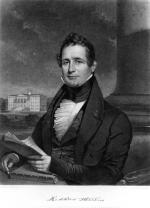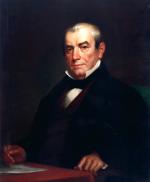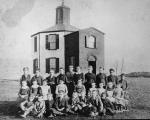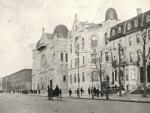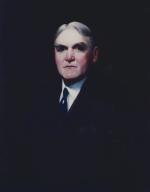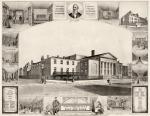Chapter Two: Staying the "Battle Axe of Ignorance": The Rise of Public Education
In his 1831 address to the state legislature Governor  George Wolf championed the cause of universal public education in words that recalled William Penn's own vision for the Commonwealth. "The state of public morals calls for it," Wolf said, "and the security and stability of the individual privileges which we have inherited from our ancestors requires our immediate attention to it." Wolf was among the growing number of politicians in Pennsylvania and across America who believed public education was a cornerstone of democratic freedom and social progress in the new nation. Not everyone agreed, however, that publicly financed schools were a prudent investment.
George Wolf championed the cause of universal public education in words that recalled William Penn's own vision for the Commonwealth. "The state of public morals calls for it," Wolf said, "and the security and stability of the individual privileges which we have inherited from our ancestors requires our immediate attention to it." Wolf was among the growing number of politicians in Pennsylvania and across America who believed public education was a cornerstone of democratic freedom and social progress in the new nation. Not everyone agreed, however, that publicly financed schools were a prudent investment.
In a striking parallel to more recent debates in Pennsylvania, the advocates of church-based schools joined forces with those who feared a loss of local control to lobby against public schools. The battle raged for several years before Governor Wolf affixed his signature to the 1834 Free Schools Act, which created a system of state-regulated common school districts throughout the Commonwealth. The initiative was still in doubt when legislator Thaddeus Stevens rose in the General Assembly in February 1835 to silence its critics by condemning the "war cry and battle axe of ignorance" that jeopardized individual welfare and social progress. Ironically, that same year native son
Thaddeus Stevens rose in the General Assembly in February 1835 to silence its critics by condemning the "war cry and battle axe of ignorance" that jeopardized individual welfare and social progress. Ironically, that same year native son  William Holmes McGuffey was preparing to publish the first edition of his Eclectic Readers, whose practical pedagogy and homespun piety would help educate generations of American schoolchildren.
William Holmes McGuffey was preparing to publish the first edition of his Eclectic Readers, whose practical pedagogy and homespun piety would help educate generations of American schoolchildren.
Another set of critics were Catholics, who feared that the new common schools would teach Protestantism, in the form of the King James Bible, to their children. Tensions mounted when rumors circled that Catholics were removing bibles from schools. A Protestant mob burned thirty homes in Philadelphia's heavily Catholic Kensington neighborhood in May 1844. Two months later, another mob attacked a Catholic Church in the city's Southwark section. Only after fifteen people had died in the ensuing riot did Governor David Palmer send in the state militia to restore order.
From the 1830s onward, the Commonwealth gradually consolidated more than 1,000 local school districts under a single statewide system of instruction. In the process, the state imposed its regulatory authority over a spirited localism that Pennsylvania taxpayers have long cherished.
From the proverbial one-room schoolhouses that dotted the Pennsylvania countryside to larger urban districts like Philadelphia and Pittsburgh, public education was a patchwork quilt of local institutions whose resources, instructional quality, and teacher preparation varied widely. Recognizing its deficiencies, state politicians and educational reformers joined ranks in the 1850s to endorse a number of improvements in educational standards, curriculum, and instructional credentials. A powerful Department of Education with its own Superintendent monitored the enforcement of government directives in each of the local districts. Equally important, each county's superintendent wrested greater control from individual school directors.
one-room schoolhouses that dotted the Pennsylvania countryside to larger urban districts like Philadelphia and Pittsburgh, public education was a patchwork quilt of local institutions whose resources, instructional quality, and teacher preparation varied widely. Recognizing its deficiencies, state politicians and educational reformers joined ranks in the 1850s to endorse a number of improvements in educational standards, curriculum, and instructional credentials. A powerful Department of Education with its own Superintendent monitored the enforcement of government directives in each of the local districts. Equally important, each county's superintendent wrested greater control from individual school directors.
To address concerns about inadequate teacher preparation, the 1857 Normal School Act created the foundation for a network of ten (later expanded to fourteen) state academies to prepare public school teachers. Two years later, a panel led by future governor Andrew Curtin recommended that a private institute near Lancaster (today's Millersville University) become Pennsylvania's first state normal school. Breaking new ground, the normal schools were coeducational, admitting both men and women who sought teaching credentials.
Millersville University) become Pennsylvania's first state normal school. Breaking new ground, the normal schools were coeducational, admitting both men and women who sought teaching credentials.
Publicly financed colleges were a natural extension of the commitment to educational opportunities at the lower grades. During the Civil War, public education took a great step forward at the national level with passage of the 1862 Morrill Land Act. With funds from the sale of federal lands, states across the country established land grant colleges for the improvement of American agriculture and extractive industries. Founded in 1855, the Pennsylvania Farmers High School (today's Penn State University) became the Commonwealth's sole land-grant college in 1862, and a center of scientific agricultural education under its first president,
Pennsylvania Farmers High School (today's Penn State University) became the Commonwealth's sole land-grant college in 1862, and a center of scientific agricultural education under its first president,  Evan Pugh.
Evan Pugh.
Over the next several decades, the foundation of Pennsylvania's other great public universities unfolded. In 1884, Philadelphia's Baptist minister Russell Conwell founded Temple College (today's Temple University) for the education of young working-class men and women. In 1908 Western Pennsylvania University adopted a new name–University of Pittsburgh–and public status. There, at the university's Allegheny Observatory, Samuel Pierpont Langley conducted pioneering experiments on flight, and
Allegheny Observatory, Samuel Pierpont Langley conducted pioneering experiments on flight, and  John A. Brashear designed and constructed a telescope that provided unprecedented accuracy in measuring the distance of stars.
John A. Brashear designed and constructed a telescope that provided unprecedented accuracy in measuring the distance of stars.
In the late 1800s, Pennsylvania witnessed other new ventures in "public" education. In Pennsylvania coal country, magazine publisher Thomas J. Foster in 1895 organized the International Correspondence Schools of Scranton, Pennsylvania, to provide a practical education for miners. Within eight years, more than 190,000 students were enrolled in ICS correspondence courses that provided "practical men with a technical education, and technical men with a practical education."
International Correspondence Schools of Scranton, Pennsylvania, to provide a practical education for miners. Within eight years, more than 190,000 students were enrolled in ICS correspondence courses that provided "practical men with a technical education, and technical men with a practical education."
Seeking to do good works with his vast fortune, Andrew Carnegie began to fund the construction of more than 2,500 libraries around the world, including Carnegie Library at Homestead, in order to bring to the working man and woman "the taste for reading." Carnegie and other philanthropists funded art museums, galleries, and other cultural institutions to improve and ennoble the lives of the poor and working-class Americans.
Carnegie Library at Homestead, in order to bring to the working man and woman "the taste for reading." Carnegie and other philanthropists funded art museums, galleries, and other cultural institutions to improve and ennoble the lives of the poor and working-class Americans.
Middle-class Pennsylvanians also embraced the movement for educational self-improvement. Starting in the early 1890s, thousands of families gathered at Mount Gretna to participate in the Pennsylvania Chautauqua, an educational summer camp that attracted lecturers and performers drawn from across the country.
Pennsylvania Chautauqua, an educational summer camp that attracted lecturers and performers drawn from across the country.
Recognizing education's essential role in Americanizing immigrant children and adults through the teaching of discipline, patriotism, and skills needed in the modern, industrial world, Americans also turned to educators for political leadership. In 1912 they elected Woodrow Wilson, who had begun his academic career as a professor at Bryn Mawr, an all-female Quaker college on the Philadelphia Main Line, as president of the United States. Two years later, the citizens of Pennsylvania elected professor Martin G. Brumbaugh their governor. Brumbaugh remains the first and only Ph.D. and former college president (of Juniata) to hold that office.
Martin G. Brumbaugh their governor. Brumbaugh remains the first and only Ph.D. and former college president (of Juniata) to hold that office.
Sweeping changes occurred in public education during and after the First World War, as modern theories of teaching and learning transformed educational pedagogy. After 1911, the Commonwealth purchased Millersville, Edinboro, and the other state normal schools that were to become the state university system, but continued to fund state-related universities–
Edinboro, and the other state normal schools that were to become the state university system, but continued to fund state-related universities– University of Pittsburgh, Penn State, Temple and
University of Pittsburgh, Penn State, Temple and  Lincoln University–whose more diversified curriculum included legal, dental, medical, and other courses of professional study.
Lincoln University–whose more diversified curriculum included legal, dental, medical, and other courses of professional study.
The Commonwealth also began to assume greater responsibility for the education of students with disabilities. In addition to opening a network of hospitals and other institutions, the Commonwealth took direct control of schools for the blind and hearing imported. In 1916, for example, it acquired the Scranton School for the Deaf, founded by Rev. Jacob Koehler, which it renamed the Pennsylvania State Oral School for the Deaf.
Rev. Jacob Koehler, which it renamed the Pennsylvania State Oral School for the Deaf.
In 1921, passage of the Edmonds Act cemented state control over the operation of local schools. It also created a new State Council of Education to oversee all public educational policy from the elementary to the college level, including all teacher training and certification programs; expanded teacher certification requirements to require a four-year degree; and new subsidies for rural, vocational and special education programs. By the end of the decade, the state normal schools had become teacher colleges with the ability to confer baccalaureate degrees.
During the Great Depression, private and public educational institutions struggled to survive as enrollments declined and revenues shrank. When the state cut its appropriations to public schools by one-third, schools slashed salaries and hundreds of teachers joined the ranks of the unemployed. As conditions worsened, the legislature in 1937 authorized county school directors to consolidate and reorganize districts and to close local schools. Pennsylvania's educational institutions survived the challenges of the Great Depression and by the end of World War II were poised to greet the rush of returning veterans and embrace the sweeping social and economic changes of the post-war era.
In a striking parallel to more recent debates in Pennsylvania, the advocates of church-based schools joined forces with those who feared a loss of local control to lobby against public schools. The battle raged for several years before Governor Wolf affixed his signature to the 1834 Free Schools Act, which created a system of state-regulated common school districts throughout the Commonwealth. The initiative was still in doubt when legislator
Another set of critics were Catholics, who feared that the new common schools would teach Protestantism, in the form of the King James Bible, to their children. Tensions mounted when rumors circled that Catholics were removing bibles from schools. A Protestant mob burned thirty homes in Philadelphia's heavily Catholic Kensington neighborhood in May 1844. Two months later, another mob attacked a Catholic Church in the city's Southwark section. Only after fifteen people had died in the ensuing riot did Governor David Palmer send in the state militia to restore order.
From the 1830s onward, the Commonwealth gradually consolidated more than 1,000 local school districts under a single statewide system of instruction. In the process, the state imposed its regulatory authority over a spirited localism that Pennsylvania taxpayers have long cherished.
From the proverbial
To address concerns about inadequate teacher preparation, the 1857 Normal School Act created the foundation for a network of ten (later expanded to fourteen) state academies to prepare public school teachers. Two years later, a panel led by future governor Andrew Curtin recommended that a private institute near Lancaster (today's
Publicly financed colleges were a natural extension of the commitment to educational opportunities at the lower grades. During the Civil War, public education took a great step forward at the national level with passage of the 1862 Morrill Land Act. With funds from the sale of federal lands, states across the country established land grant colleges for the improvement of American agriculture and extractive industries. Founded in 1855, the
Over the next several decades, the foundation of Pennsylvania's other great public universities unfolded. In 1884, Philadelphia's Baptist minister Russell Conwell founded Temple College (today's Temple University) for the education of young working-class men and women. In 1908 Western Pennsylvania University adopted a new name–University of Pittsburgh–and public status. There, at the university's
In the late 1800s, Pennsylvania witnessed other new ventures in "public" education. In Pennsylvania coal country, magazine publisher Thomas J. Foster in 1895 organized the
Seeking to do good works with his vast fortune, Andrew Carnegie began to fund the construction of more than 2,500 libraries around the world, including
Middle-class Pennsylvanians also embraced the movement for educational self-improvement. Starting in the early 1890s, thousands of families gathered at Mount Gretna to participate in the
Recognizing education's essential role in Americanizing immigrant children and adults through the teaching of discipline, patriotism, and skills needed in the modern, industrial world, Americans also turned to educators for political leadership. In 1912 they elected Woodrow Wilson, who had begun his academic career as a professor at Bryn Mawr, an all-female Quaker college on the Philadelphia Main Line, as president of the United States. Two years later, the citizens of Pennsylvania elected professor
Sweeping changes occurred in public education during and after the First World War, as modern theories of teaching and learning transformed educational pedagogy. After 1911, the Commonwealth purchased Millersville,
The Commonwealth also began to assume greater responsibility for the education of students with disabilities. In addition to opening a network of hospitals and other institutions, the Commonwealth took direct control of schools for the blind and hearing imported. In 1916, for example, it acquired the Scranton School for the Deaf, founded by
In 1921, passage of the Edmonds Act cemented state control over the operation of local schools. It also created a new State Council of Education to oversee all public educational policy from the elementary to the college level, including all teacher training and certification programs; expanded teacher certification requirements to require a four-year degree; and new subsidies for rural, vocational and special education programs. By the end of the decade, the state normal schools had become teacher colleges with the ability to confer baccalaureate degrees.
During the Great Depression, private and public educational institutions struggled to survive as enrollments declined and revenues shrank. When the state cut its appropriations to public schools by one-third, schools slashed salaries and hundreds of teachers joined the ranks of the unemployed. As conditions worsened, the legislature in 1937 authorized county school directors to consolidate and reorganize districts and to close local schools. Pennsylvania's educational institutions survived the challenges of the Great Depression and by the end of World War II were poised to greet the rush of returning veterans and embrace the sweeping social and economic changes of the post-war era.







